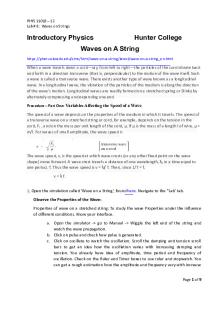ECE350 Lab Report 8 - Principles Of Automatic Control PDF

| Title | ECE350 Lab Report 8 - Principles Of Automatic Control |
|---|---|
| Course | Principles Of Automatic Control |
| Institution | University of Illinois at Chicago |
| Pages | 8 |
| File Size | 653.4 KB |
| File Type | |
| Total Downloads | 66 |
| Total Views | 132 |
Summary
Semester: Spring 2017
Professor: Ning Jin
Document: Lab report of eighth lab....
Description
ECE 350: Principles of Automatic Control Experiment 8
Student: Teaching Assistant: Session: Group:
ECE 350
Objective: The purpose of this experiment is to use Matlab and Simulink to build a nonlinear system and study and compare its behavior with its linearization. Consider a pendulum system, which is a point mass m swinging on a mass-less rod of length l. For the simulation, use the values m = 1kg and l = 1m.
As it has been obtained in last experiment, the motion of the mass can be described by differential equation
Here, function sin(φ) is a nonlinear function. So, the pendulum system is nonlinear. Experiment Results: Part a: Derive the linearization of (1) by replacing the nonlinear function sin( φ) with its first order Taylor series around the point φ=0. Recall that a Taylor series of a function f(x) of x around the point x0 is:
Keep the linear terms and drop all the high degree terms, then we have the first order Taylor series, i.e., the linearization of, f(x) around x0:
If you performed the calculations correctly, the linearization of (1) should have the form: 2| Σ ε λ ί δ α
ECE 350
where α and β are constants. Determine α and β. Then build system (2) in Simulink. Use “Integrator” and “Gain”. Use a “Scope” to display the output φ. The initial condition will be set as φ(0) = 5° and φ´ (0) = 0. Run the system and print your result. Since m = 1kg, l = 1m, and g = 9.8 then we have α = 9.8 with β = 0.
3| Σ ε λ ί δ α
ECE 350
Part b: Let x 1=φ and x 2=´φ . Then we can have the state space model of the pendulum system:
Now, derive the linearization of (3) by replacing the nonlinear function sin( x1) with its first order Taylor series around x1=0. If you performed the calculations correctly, the linearization of (3) should have the form:
where A is a constant 2 × 2 matrix. Determine A. Then build the system (4) in Simulink. Use “Integrator” and “Gain”. Use a “Scope” to display the output x1. The initial condition will be set as x1=5o and x2=0. Run the system and print your result. The output should be same with the output of part (a). A=
[ 9.80 10]
4| Σ ε λ ί δ α
ECE 350
Part c: We would like to compare how well the linearized system describes the pendulum. First, build the pendulum system (1) (or (3)) and its linearization (2) (or (4)) in one Simulink model, use a “Mux” to combine the outputs of these two system and display them in one scope. You will need to set the initial conditions as follows:
Run the simulation for 10s for each of the initial conditions. Print the results in each case. What can you say about the relation between the behavior of the pendulum and that of the linearized system?
5| Σ ε λ ί δ α
ECE 350
Case I:
6| Σ ε λ ί δ α
ECE 350
Case II:
Case III:
7| Σ ε λ ί δ α
ECE 350
Case IV:
Based on each case’s simulations, we can conclude that there is a direct relationship between pendulum’s behavior and that of the linearized system.
8| Σ ε λ ί δ α...
Similar Free PDFs

ECE350 Lab Report 7
- 5 Pages

Automatic Stock Control
- 6 Pages

Automatic street light control
- 9 Pages

Lab 8 - lab report
- 6 Pages

Level Control lab report
- 9 Pages

Lab 8 - lab report
- 3 Pages

LAB #8 - Lab report
- 4 Pages

Docx-8 - lab 8 lab report of 238
- 2 Pages

Phys lab 8 - Lab report
- 9 Pages

Lab Report 8 stoichiometry
- 10 Pages

Analyticalchemlab 8 - Lab report
- 5 Pages

Lab 8 CHM - lab report
- 3 Pages

Experiment 8 Lab Report
- 8 Pages

Chem lab report 8
- 5 Pages
Popular Institutions
- Tinajero National High School - Annex
- Politeknik Caltex Riau
- Yokohama City University
- SGT University
- University of Al-Qadisiyah
- Divine Word College of Vigan
- Techniek College Rotterdam
- Universidade de Santiago
- Universiti Teknologi MARA Cawangan Johor Kampus Pasir Gudang
- Poltekkes Kemenkes Yogyakarta
- Baguio City National High School
- Colegio san marcos
- preparatoria uno
- Centro de Bachillerato Tecnológico Industrial y de Servicios No. 107
- Dalian Maritime University
- Quang Trung Secondary School
- Colegio Tecnológico en Informática
- Corporación Regional de Educación Superior
- Grupo CEDVA
- Dar Al Uloom University
- Centro de Estudios Preuniversitarios de la Universidad Nacional de Ingeniería
- 上智大学
- Aakash International School, Nuna Majara
- San Felipe Neri Catholic School
- Kang Chiao International School - New Taipei City
- Misamis Occidental National High School
- Institución Educativa Escuela Normal Juan Ladrilleros
- Kolehiyo ng Pantukan
- Batanes State College
- Instituto Continental
- Sekolah Menengah Kejuruan Kesehatan Kaltara (Tarakan)
- Colegio de La Inmaculada Concepcion - Cebu

